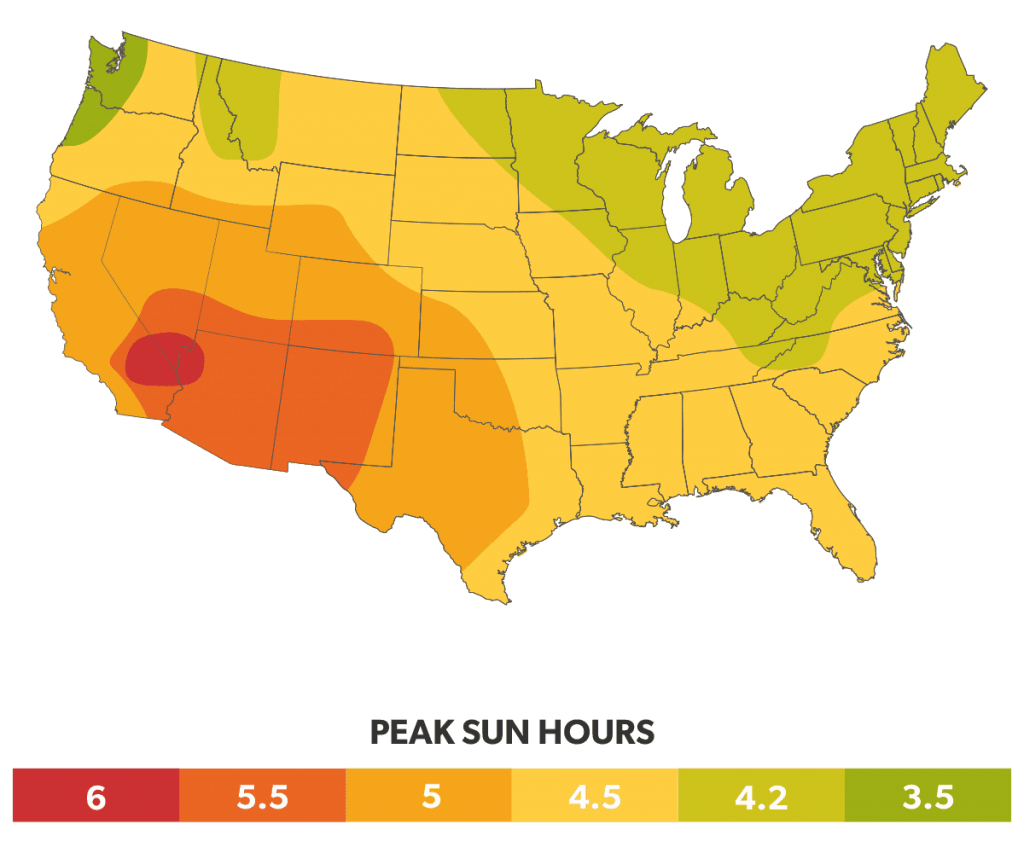Sun Hours Map: How Many Sun Hours Do You Get?
Do-It-Your-Way Solar Guide
TABLE OF CONTENTS
- Pros, Cons, and Costs
- Pros and Cons of Solar
- Are Solar Panels Worth It?
- Solar Panel Cost Calculator
- Solar Panels ROI
- Federal Solar Tax Credit
- State Solar Incentives
- Solar Lease Guide
- Should You Lease Solar?
- Solar Financing
- Planning
- Do Solar Panels Increase Home Value?
- Community Solar
- Sun Hours Map
- Solar Electrical Requirements
- Solar Permitting
- Net Metering Guide
- DIY or Contractor Install
- System Design
- Grid-Tied vs. Off-Grid
- How to Size Your Solar System
- Solar Panel Efficiency
- 60 Cell vs. 72 Cell Solar Panels
- Monocrystalline vs. Polycrystalline Solar Panels
- Best Solar Panels
- Microinverters vs. String Inverters
- Best Grid-Tied Inverters
- Ground Mount vs. Roof Mount Racking
- Best Solar Panel Mounts
- Lead-Acid vs. Lithium Batteries
- Best Solar Batteries
- Battery Backup for Grid-Tied
- Installation
- Step-by-Step DIY Solar Installation
- Part 1: Planning & Safety
- Part 2: Wiring & Electrical
- Part 3: Mounting Your Panels
- Part 4: Battery Installation
- Off-Grid Solar Commissioning
- Monitoring & Maintenance
- Best Solar Panel Monitoring
- Solar Panel Maintenance Cleaning
When deciding to switch to solar, you’ll want to know how many peak sun hours you typically get in your geographic area to give you an accurate estimate of the production of your system.
Average peak sun hours vary greatly across the country; how much sunlight intensity you get in your state—or even the given sun hours per day by zip code—can make a dramatic difference and directly impact the effectiveness of going solar.
Before you decide to go solar, you’ll want to assess how many peak sun hours you typically get and how much sun your solar panels need to work optimally.
Use our peak sun hours map to find out your average sun peak hours to determine if you can make the most of the solar power available to you.
What Are Peak Sun Hours?
Peak sun hours differ from hours of daylight; the peak sun hour actually describes the intensity of sunlight in a specific area, defined as an hour of sunlight that reaches an average of 1,000 watts of power per square meter (around 10.5 feet).
Although your panels may get an average of 7 hours of daylight a day, the average peak sun hours are generally around 4 or 5. Solar radiation peaks at solar noon, when the sun reaches the highest point in the sky.
The number of peak sun hours you get per day increases the closer you are to the equator and typically during the summer months.
What Are My Average Peak Sun Hours?
Knowing the average peak sun hours where you live is the one of the best ways to determine if you should go the solar route. Depending on your location, you’ll see a major difference in the average peak sunlight hours. The United States averages between 3 to 5 peak sun hours in most areas.
Select the city closest to you to determine your average peak sunlight hours, or select another city in the solar sun map to compare how peak sun hours vary from state to state:
Peak Sun Hours Map

The legend indicates the average (over the course of the year) amount of solar insolation (full sun hours) for these zones.
These figures are based on the yearly average; consequently, systems based on these figures will provide more power in summer and less in winter. Winter figures for daily solar gain may be from 25% to 50% less than these average figures.
How Much Sun Do Solar Panels Need?
Solar panels need direct sunlight to produce the maximum solar output. To maximize the sunlight the solar panels receive, face the panels in a southward direction and install them in an area where they are not shaded by trees or other obstructions.
Just a small amount of shade on a solar panel can affect its power output. Your solar panel cells are connected in a series string, meaning that any cell that’s affected by shade can weaken the other cell panels, reducing the overall power level. Before you go solar, you’ll want to check that you have an area for your solar panel with minimal or no shading (recommended), or use a string inverter with MPPT (maximum power point tracking) to minimize output loses associated with partial shading.
Our solar professionals can help you determine the best placement for your panels. In addition to our sun hour map, We do also have additional insolation data available for other parts of the world to determine how many peak sun hours you have to go solar. Email us at [email protected] and give us the location of your solar project. We’ll help you design your solar power system. You can also call us at 1-800-472-1142.